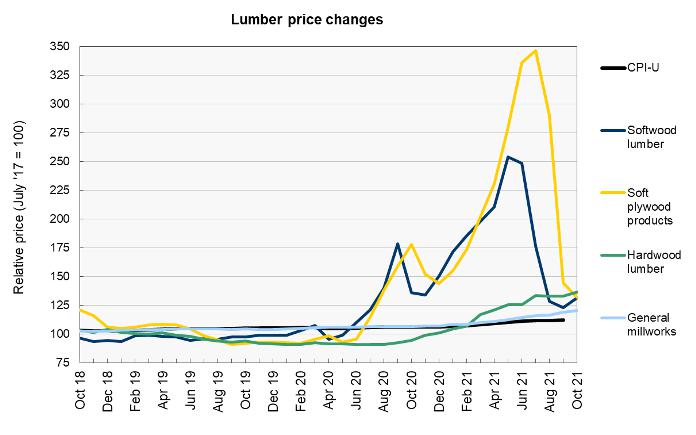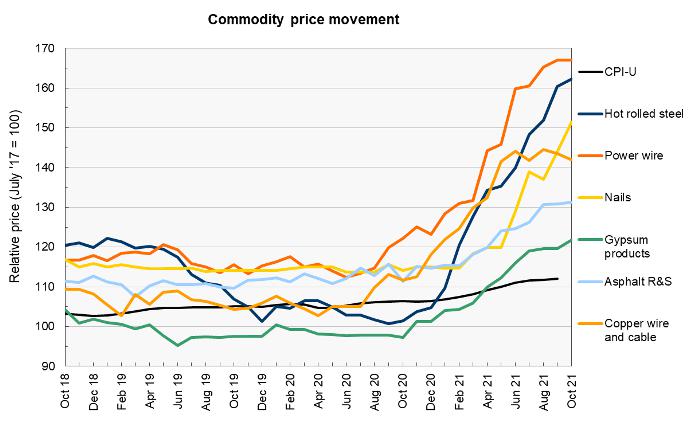The Bureau of Labor Statistics (BLS) released its producer price index report for October 2021. It showed that construction materials prices were up 1.2 percent in the month, seasonally adjusted. The index of components and materials for construction was 18.4 percent higher than its year-earlier level.
Overall prices for processed goods for intermediate demand rose by 1.7 percent in the month. The index was 25.4 percent higher than its year-earlier level.
For reference, the changes in these indices compare with a 6.2 percent rise in the all-items consumer price index (CPI-U) for the 12 months ending in October. The CPI-U was up 0.9 percent for the month.
Yield Pro (PRO) compiled the BLS reported price changes for our standard list of construction commodities. These are commodities whose prices directly impact the cost of constructing an apartment building. The two right hand columns of the table provide the percent change in the price of the commodity from a year earlier (12 Mo PC Change) and the percent change in price from September 2021 (1 Mo PC Change). If no price data is available for a given commodity, the change is listed as N/A.
The pre-COVID column lists the change in the current commodity prices relative to the average prices in the first three months of 2020, before the pandemic impacted the economy. This may give a truer idea of the magnitude of the recent price increases than does the 12 Mo PC Change column for commodities, such as lumber, whose prices were already rising sharply last summer.
| Commodity | 12 Mo PC Change | 1 Mo PC Change | Pre-COVID Change |
| Softwood lumber | -19.5 | 7.3 | 27.8 |
| Hardwood lumber | 45.6 | 2.4 | 48.7 |
| General millworks | 13.0 | 1.3 | 14.7 |
| Soft plywood products | -18.5 | -8.7 | 41.4 |
| Hot rolled steel bars, plates and structural shapes | 60.0 | 1.2 | 54.1 |
| Copper wire and cable | 26.3 | -1.1 | 33.9 |
| Power wire and cable | 37.1 | 0.0 | 43.6 |
| Builder’s hardware | 17.0 | 5.5 | 16.9 |
| Plumbing fixtures and fittings | 3.5 | -0.5 | 4.3 |
| Enameled iron and metal sanitary ware | 1.1 | 0.0 | 3.9 |
| Furnaces and heaters | 11.9 | 4.0 | 13.0 |
| Sheet metal products | 32.0 | 1.1 | 31.5 |
| Electrical Lighting fixtures | 11.0 | 2.8 | 10.0 |
| Nails | 32.7 | 5.2 | 32.3 |
| Major appliances | 7.7 | 0.2 | 10.1 |
| Flat glass | 12.5 | 1.9 | 12.6 |
| Ready mix concrete | 4.3 | 0.1 | 5.1 |
| Asphalt roofing and siding | 17.7 | 0.3 | 17.0 |
| Gypsum products | 25.1 | 1.8 | 22.1 |
| Mineral wool insulation | 21.6 | -1.7 | 20.0 |
The first chart, below, shows the price index history for wood products over the past 25 months. Note that the construction materials prices used by the BLS in compiling the indexes are collected on the Tuesday of the week containing the 13th day of the month. In October 2021 that would have been October 12.

Softwood lumber prices were reported to be down, year-over-year, in October. However, lumber prices had been rising sharply in the months leading up to October 2020, so current prices could be down year-over-year but still be elevated. Compared to pre-COVID prices, softwood lumber prices were up significantly in October 2021. More concerningly, they were up from September’s level after falling for several months.
Looking at the market price history for lumber, prices had spiked to over $700 around the time that the BLS took its reading for October. Since then, prices have trended down slightly and are now trading just under $600, so there is hope that October’s lumber price rise may be reversed in November.
Lumber prices in the futures markets are indicating that prices are expected to rise going forward. While the January 2022 contract was trading at $651 in early November, the March 2022 contract was at $675 and the July 2022 contract was trading at $705. One positive sign is that, when we last looked at these prices, the March 2022 contract was trading near $800.
Soft plywood prices were down both month-over-month and year-over-year according to the BLS. However, the table above shows that soft plywood prices are up significantly from their levels before the pandemic.
The next chart, below, shows the recent history of several other construction materials prices. While lumber prices and plywood prices have gotten the headlines, of the commodities we track, hot-rolled steel prices are now up by the greatest percentage compared to their pre-COVID levels. The prices of nails, power wire and copper wire are also all up more than 30 percent from their pre-COVID levels.

MarketWatch reports that the NYSE American steel index has been relatively stable for the last month. It closed on October 12 at $1,581 and was trading near $1,560 in early November. Steel futures are up since last month, with the January 2022 contract priced at $1,565 recently and the April 2022 contract priced at $1,305.
The price of copper has continued its recent volatility, trading as high as $4.72 per pound in late October and as low as $4.32 in early November. The good news is that the sharp run-up in prices that took copper from $2.16 per pound in April 2020 to $4.74 in May 2021 seems to be over for now.
The price of aluminum may have finally crested. It reached $3,168 on October 18 but dropped to $2,605 on November 9. It had been trading around $1,800 in late 2019.
The prices of the other commodities tracked in this chart have been rising since late last year. Asphalt roofing and siding is the commodity whose price has risen the least of those shown. It is up “only” 17 percent from its pre-COVID level.
Price changes for several of the more finished goods from our sample are illustrated in the final chart, below. Electrical lighting fixtures prices and furnaces and heaters prices have moved sharply higher recently while plumbing fixtures and fittings and enameled iron and metal sanitary ware are two of the only 3 items on are our construction commodity list whose prices have not increased by double digit percentages over their pre-COVID levels.

The full BLS report can be found here.












